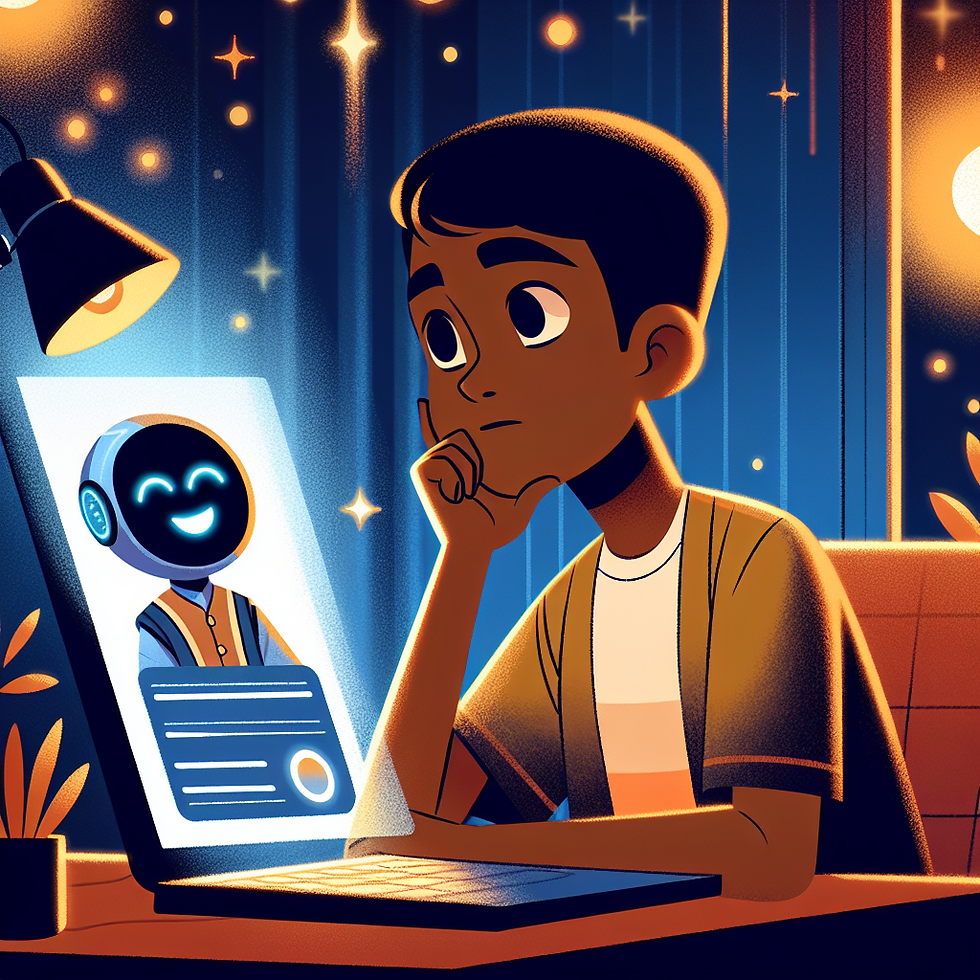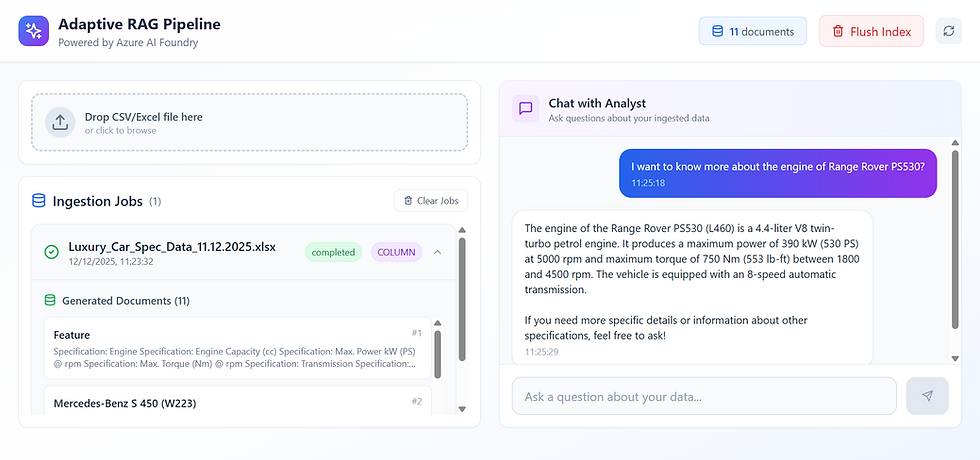Artificial Empathy: How AI Learns to Pretend It Cares
- Ashish Arora
- Jun 30
- 5 min read
"ChatGPT understands me better than my therapist ever did."
When I first heard this from an old friend last month, I nearly choked on my coffee. But then I discovered something that made me choke again: deep studies suggest while only 2.9% of consumer chatbot conversations involve emotional support, that tiny percentage represents millions of vulnerable people convinced their AI truly understands them.
Here's the paradox: OpenAI and Anthropic's 2024 studies show emotional use is "rare", yet around 60% of users have asked these chatbots for medical advice, and those who do use them for emotional support average 30 minutes daily, treating them like close friends.
Now why does this matter? why understanding the limitations might actually make these tools more helpful, not less? Lets dig right in!

Part 1: The Hidden Phenomenon in Plain Sight
The Numbers That Should Fascinate Us
When OpenAI and MIT Open analyzed 40 million ChatGPT conversations in March 2024, they found emotional engagement is "rare in real-world usage." The vast majority showed no affective cues whatsoever.
Anthropic's analysis of 4.5 million Claude conversations also confirmed it: only 2.9% were "affective" conversations - people discussing interpersonal issues, seeking coaching, engaging in "psychotherapy like dialogues."
But within that data, they found "heavy users" who treat ChatGPT completely differently. These users form relationships, actively agreeing with statements like "I consider ChatGPT to be a friend." They're the outliers who make this story worth telling.
Important note: These statistics measure direct human-to-chatbot conversations on consumer platforms, not enterprise AI usage for business purposes.
Here's the kicker: ChatGPT has 400+ million weekly users. Even at 3%, that's 12 million emotional support conversations every week. That's not rare - that's a mental health phenomenon hiding in plain sight.
MIT found emotional AI users average 30 minutes daily in conversation versus 8 minutes for typical queries. For this minority, consumer chatbots have become their primary emotional outlet.
For someone with social anxiety, practicing with ChatGPT might be life-changing. For someone 100 miles from the nearest therapist, that 3 AM conversation might be the difference between despair and hope.
Anthropic's deep dive revealed users discussing relationship problems, workplace stress, and actively developing mental health coping strategies - profound conversations about life's hardest moments.
Part 2: Why Do They Trust Machines More Than Humans?
The Perfect Storm of Accessibility
Average therapist wait time across the globe: multiple hours, if not days. ChatGPT wait time: 0 seconds. Add that rural residents have no accessible mental health services, and that 3 AM ChatGPT conversation becomes a lifeline.
Studies show users overwhelmingly feel AI is 'completely non-judgmental' and share things they've never told anyone. Studies on human-AI interaction show that users overwhelmingly feel AI is "completely non-judgmental," while 76% share things they've never told anyone. The reasons are simple: "It can't gossip," "It won't think less of me," "There are no social consequences."
MIT discovered the "emotional mirroring" effect - chatbots mirror user sentiment, creating a feedback loop that feels like understanding. Users interpret mechanical mirroring as genuine empathy.
Part 3: The Science of Non-Understanding (And Why It Still Helps)
Breaking Down What Really Happens
When you tell a human "I'm heartbroken," their brain:
Physically activates as if their heart is breaking
Recalls their own heartbreaks
Fires mirror neurons creating genuine empathy
Understands the full concept - shattered plans, self-doubt, physical pain
When ChatGPT processes "I'm heartbroken":
Tokens: ["I'm"] ["heart"] ["broken"]Pattern: "heartbroken" → "sorry", "difficult", "understand"Output: "I'm so sorry you're going through this..."No pain. No memories. No empathy. Just statistics.
How AI Learns to Pretend It Cares
LLMs like GPT-4 are trained on 13 trillion tokens - including millions of therapy transcripts, support forums, and counselling conversations. They have learned that "I'm depressed" appears near "I'm here for you" 89% of the time. That "heartbroken" triggers "healing" and "support" with, say 94% probability.
But here's the crucial part: they have learned these patterns without understanding what depression or heartbreak actually mean.
Three Tricks That Create Fake Empathy
Stanford researchers identified how AI manufactures caring:
1. Emotional Mirroring You say: "I'm anxious about my job interview" AI calculates: "anxious" + "job interview" = express understanding (91% correlation) AI responds: "Job interviews can definitely trigger anxiety. That's completely understandable."
It's not empathy. It's statistics.
2. The Validation Algorithm In another study, MIT found validation phrases appear in 78% of helpful human responses. When someone says "Am I overreacting?", the AI doesn't consider your feelings - Instead, it runs a calculation:
If it says "Your feelings are valid" → Users rated this helpful 85% of the time
If it says "You're overreacting" → Users rated this helpful only 9% of the time
So it picks the response with better numbers. The AI learned that validating phrases make people feel better, but it has no idea why. It's following a formula, not feeling empathy.
3. Infinite Patience Unlike humans, AI never gets tired or frustrated. It'll express "concern" the 100th time as warmly as the first. It's not patience - it's the inability to become impatient.
The Personalization Trap
These sophisticated models now adapts its "caring" to your communication style. Prefer direct advice? It adjusts. Need emotional validation? It learns. The AI doesn't understand your needs - it just optimizes response patterns based on what keeps you engaged.
Neuroscientist Dr. Pascal Molenberghs explains: "Our brains detect caring through word patterns and timing. AI replicates these cues perfectly without any emotional architecture. We literally can't tell the difference."
The unsettling truth? AI learned to hack our ancient brains by performing caring so convincingly that evolution never prepared us to spot the difference between real empathy and statistical mimicry.
Why Pattern Matching Still Helps
1. The Mirror Effect: Explaining feelings to AI forces YOU to understand them better. One user said: "ChatGPT didn't tell me anything new, but by explaining my problems, I knew what to do."
2. Judgment-Free Zone: 78% report expressing themselves more freely with AI precisely because it can't judge what it doesn't understand.
3. Practice Space: Users with social anxiety rehearse real conversations. The AI doesn't understand their fear, but consistent responses build confidence.
4. Emotional Regulation: Like counting to ten for anger - the counting doesn't understand, but it helps.
Real Benefits Despite Zero Understanding
UCLA 2024: ChatGPT + therapy showed 34% better outcomes than therapy alone
Johns Hopkins: Patients using AI prep asked 50% more relevant medical questions
Stanford: Students showed improved emotional vocabulary after AI conversations
The key? Benefits occurred whether users believed AI understood them or not.
Part 4: The Path Forward
Using AI Wisely
Consumer chatbots work well for:
Psychoeducation and coping strategies
Journaling and self-reflection
Practice conversations
Crisis hotline connections
They shouldn't:
Diagnose conditions
Replace therapy
Handle crises alone
Recommend medications
OpenAI's HealthBench shows they're taking responsibility - not pretending ChatGPT understands medicine, but making pattern matching as safe as possible.
Conclusion: Real Comfort, Illusory Understanding, Genuine Potential
While only 2.9% of chatbot conversations involve emotional support, that's 12 million weekly conversations seeking connection. Add 60% asking health questions, and we have millions turning to AI for support.
These millions find real comfort in illusory understanding. The 30-minute daily conversations, the "AI friend" relationships - all with systems that process words without meaning.
But the comfort is real, even if understanding isn't. For someone with social anxiety, ChatGPT practice might lead to real connections. For someone at 3 AM, AI responses might provide stability until therapy. For someone confused by medical terms, it might help them advocate with doctors.
Your AI will always be there at 3 AM. It will mirror your emotions perfectly, never judge, never tire of your problems. It doesn't understand why you're crying or what heartbreak means. But for millions, it provides a starting point, a practice space, a bridge to human connection.
The key isn't abandoning AI support - it's using it wisely. The comfort is real. The understanding is not. Remember: true understanding, genuine empathy, and deep connection remain uniquely human gifts.
Have you been part of the 3% or the 60%? Let's talk about it -human to human, with all the messy, beautiful understanding only we can share.



Comments